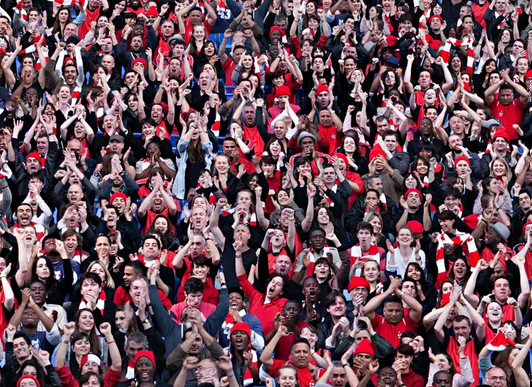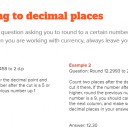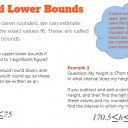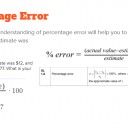Accuracy and Estimation
When numbers are reported in the news, or as statistical results, they are either displayed exactly, or they are rounded to a certain degree of accuracy. Understanding how and when to do this can give us a deeper insight into the important numbers we run into in our daily lives. When numbers are estimated, it leads to a lack of accuracy, the size of which can be represented by the percentage error. We will also learn how to find this in this chapter.
In this unit you should learn to…
-
Round using decimal places and significant figures
-
Find the upper and lower bounds of rounded numbers
-
Estimate the result of a calculation using rounding
-
Find the percentage error of a calculation
Self Checking Quiz
Practice your understanding on these quiz questions. Check your answers when you are done and read the worked solutions when you get stuck. If you find there are still some gaps in your understanding then go back to the videos above.
Which of the following is 14.7854 correctly rounded to 3 significant figures
14.8 - the third non zero digit is 7, which is rounded up to 8 because of the 8 that follows
Which of the following is 0.003046 correctly rounded to 3 significant figures
0.00305 - the third non zero digit is 4, which is rounded up to 7 because of the 6 that follows
Which of the following is 12348 correctly rounded to 3 significant figures
12300 - the third non zero digit is 3, which stays the same because of the 4 that follows
Which of the following is 6504905 correctly rounded to 3 significant figures
6500000 - the third non zero digit is 0, which stays the same because of the 4 that follows
Which of the following is 452756 correctly rounded to 3 significant figures
453000 - the third non zero digit is 2, which becomes 3 because of the 7 that follows
A rectangular field measures 23m by 63m, correct to the nearest metre. What is the smallest possible area of the field in square metres? (Give the exact answer)
The lower limt of both measurements are 22.5 and 62.5.
22.5 x 62.5 = 1406.25
A rectangular field measures 15m by 21m, correct to the nearest metre. What is the upper limit for the area of the field in square metres? (Round your answer to 3sf))
The upper limt of both measurements are 15.5 and 21.5.
15.5 x 21.5 = 333.25, which is 333 when rounded to 3sf
A bucket is used to lower the level of water in a swimming pool - 100 full buckets were removed. The bucket is advertised with a capcity of 3 litres, The actual capacity of the bucket is 3.2 litres. What is the percentage error if the marketed capacity is used to calculate the volume of water that is removed?
\(Volume\quad using\quad marketing\quad capacity\quad =\quad 300l\\ Actual\quad volume\quad =\quad 320l\\ Percentage\quad error\quad =\quad \frac { 320-300 }{ 320 } \times 100=6.25\)
Hannah estimates that the sum of the first 20 terms of the following sequence, \({ U }_{ n }=12+8(n-1)\), is 2000. What is her percentage error
\({ U }_{ n }=12+8(n-1)\\ n=20,\quad { U }_{ 1 }=12,\quad d=8\\ S_{ 20 }=\frac { 20 }{ 2 } (24+8(20-1))=1760\\ Error\quad =\quad \frac { 2000-1760 }{ 1760 } \times 100=13.6\quad (3sf)\)
Nick converted 300 Zambia Kwechas (ZMW) to Euros (EUR) and the bank were offering an exchange rate of 1 ZMW = 0.049 EUR. If he converted 300 and got 14 EUR, how much commission was he charged?
The conversion rate is
\(1\quad ZMW\quad =\quad 0.049\quad EUR\)
so converting 300 ZMW gives:
\(300\quad ZMW\quad =\quad 14.7\quad EUR\)
Buzz got 14 so he paid 0.7 EUR in commission, making the percentage difference:
\(\frac{0.7}{14.7}\cdot100=4.76\)
The following questions are based on IB exam style questions from past exams. You should print these off (from the document at the top) and try to do these questions under exam conditions. Then you can check your work with the video solution.
Given \(a=b-\frac{\sqrt{c}}{d}\), b = 1.775, c = 1.347 and d = 32,
(a) calculate the value of a.
Luisa first writes b, c and d correct to one significant figure and then uses these values to estimate the value of a.
(b) (i) Write down b, c and d each correct to one significant figure.
(ii) Write down Luisa’s estimate of the value of a.
(c) Calculate the percentage error in Luisa’s estimate of the value of p.
(Total 6 marks)
How much of 1.6 Accuracy and Estimation have you understood?








 Twitter
Twitter  Facebook
Facebook  LinkedIn
LinkedIn